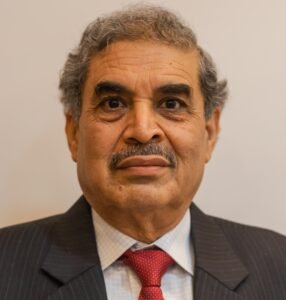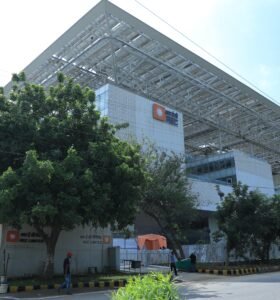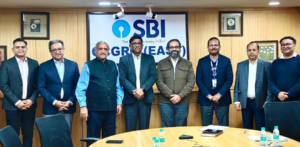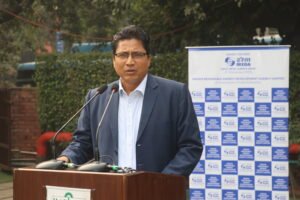Greater Noida (Hridaya Mohan): US President Donald Trump announced a new tariff policy designed to reduce the US trade deficit and boost domestic manufacturing on April 2. Over 60 countries are affected by the measures. Certain goods are exempted from these tariffs. These include aluminum, steel, auto products and critical items such as pharmaceuticals, semiconductors, copper and energy products like oil, gas, coal and LNG. The actual tariff a country faces depends on what it’s exporting and how its trade practices align with US economic and national security interests.
The new tariffs will apply equally to goods from Hong Kong and Macau, as part of efforts to prevent tariff evasion through transshipments. No tariffs were imposed on Ireland, despite a trade deficit of $89.2 billion in 2024, on Russia, Guyana and Romania, despite each exceeding $1 billion in deficits. Several low-income nations were assigned unusually high tariffs despite relatively small deficits like 37% on Botswana with $0.4 billion deficit, 44% on Myanmar with $0.6 billion deficit and 47% on Madagascar with $0.7 billion deficit.
Impact on India:
The imposition of higher reciprocal tariffs by the United States on several Asian countries, including China, Vietnam, Taiwan, Thailand, Indonesia, Bangladesh, Sri Lanka and on Pakistan too, who keeps getting caught in economic crisis one after the other, presents a strategic opportunity for India to strengthen its position in global trade and manufacturing. With the US setting a relatively lower reciprocal tariff rate of 26% on Indian goods—compared to 54% on China, 46% on Vietnam, 44% on Sri Lanka, 37% on Bangladesh and 36% on Thailand.
One of the most prominent areas of opportunity lies in textiles and garments. The high tariffs on Chinese, Vietnam’s, Bangladeshi and Sri Lankan exports create room for Indian textile manufacturers to regain the market share, attract relocated production and increase exports to the US India’s strong base in textile production, coupled with lower tariffs, could drive greater global demand and new investments in the sector. India contributes only 6-7% of US garment imports presently, far behind Bangladesh and Vietnam.
The same applies to leather goods. Vietnam’s share of leather goods import to the US is around 35-36%. India can easily compete with them in this industry too in the US market.
In the electronics, telecom and smartphone sectors, countries like Vietnam and Thailand are likely to lose cost competitiveness due to the steep US tariffs. This opens a window for India, which has already begun investing in electronics manufacturing through government incentive scheme. As global brands seek to diversify supply chains away from high-tariff countries, India can emerge as a preferred destination for new manufacturing setups and component assembly lines.
The semiconductor space, while still dominated by technologically advanced players like Taiwan, also offers potential for India to capture parts of the value chain such as packaging, testing and lower-end chip manufacturing. Even a partial shift of supply chains from Taiwan due to tariffs (32%) could benefit India if supported by adequate infrastructure and policies.
Similarly, sectors like machinery, automobiles and toys—where China and Thailand currently lead—are also vulnerable to tariff-related relocation. With strategic planning, India can attract foreign direct investment in these areas, scale up domestic production and cater to markets like the US that are seeking alternate sources for imports.
With such heavy tariffs, it will be difficult for China to remain competitive in the US market. Western countries started feeling after COVID-19 that China-centric supply chain systems could be risky for them and started setting up their units in countries like Thailand and Vietnam. Chinese companies also took the same route to avoid Trump’s first trade war. Under these circumstances, India gains a natural competitive advantage in several key sectors.
For these reasons, the discussion about “China Plus One” intensified. This also created opportunities for India and vendors like Apple’s Foxconn set up large units in India. India introduced schemes like “Performance Linked Incentive (PLI)” to reduce dependence on imports in many segments and take advantage of China Plus One, a customary tax scheme was introduced on new investments so that foreign investment increased. But India couldn’t achieve much success, so far. Countries like Vietnam and Thailand have benefited much more than us.
Need for the right policies:
Trump’s tariff announcements have brought this opportunity to India again. The Government of India needs to adopt the right policies and bring in necessary reforms like in the areas of labour laws and land acquisitions etc. for the growth and competitiveness of the manufacturing sector.
Prime Minister Narendra Modi has been focusing on strengthening the manufacturing sector since his first term. Initiatives like “Atmanirbhar Bharat” and “Make in India” are the result of his focus. Speaking with Lex Fridman recently, PM Modi mentioned, “Trump believe in America First just as I believe in India First.” It is a challenge before the government now to turn the disaster of tariffs into an opportunity.
Overall, the protectionist tariff regime of US could act as a catalyst for India to gain from global supply chain realignments. However, to fully leverage these opportunities, India must enhance its ease of doing business, invest in logistics and infrastructure and maintain policy stability. With this, India is well-positioned to become a key global manufacturing and export hub in the coming years.
About the Author

Mr. Hridaya Mohan is a regular Columnist with a renowned Indian daily “The Hitavada” and some other newspapers / magazines internationally. Superannuated as Executive Director, Steel Authority of India Ltd. (SAIL), he is Senior Adviser, Metallon Holdings Pvt. Ltd. presently. He headed SAIL office at Beijing as Chief Representative (China & Mongolia) for six years. He has published and presented seventeen papers globally. Recipient of “Sir M Visvesvaraya Gold Medal” for one of his papers, “Benchmarking of Maintenance Practices in Steel Industry” from The Institution of Engineers (India), he was awarded with “Scroll of Honour” for the excellent contributions to Engineering fraternity from IE(I), Bhilai, “Jawahar Award” for leadership excellence in SAIL and “Supply Chain Leader – 2017” award from IIMM.









